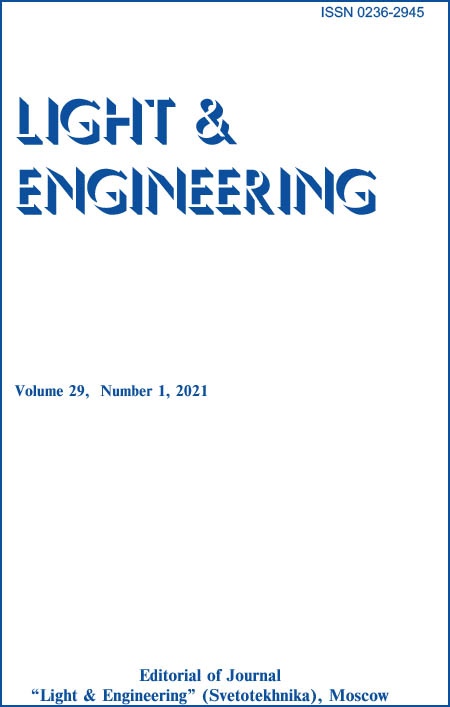Content

Light & Engineering 29 (1)
Volume 29Date of publication 02/27/2021
Pages 94–103
Abstract:
The deposition of air pollutants on glazing can significantly affect the daylight transmittance of building fenestration systems in urban areas. This study presents a simulation analysis of the impact of air pollution and glazing visual transmittance on indoor daylight availability in an open-plan office in London. First, the direct links between glazing visual transmittance and daylighting conditions were developed and assessed. Second, several simple algorithms were established to estimate the loss of daylight availability due to the pollutant deposition at the external surface of vertical glazing. Finally, some conclusions and design strategies to support facade planning at the early design stage of an urban building project were developed.
References:
1. IEA (SHC Task 21/ ECBCS Annex 29) (2000). Daylight in buildings: a source book on daylighting system and components. Report of Lawrence Berkeley National Laboratory. Available from: https://facades.lbl.gov/daylight-buildings-source-book-daylighting-systems [Accessed 10 July 2019]. 2. Boyce P., Hunte C., Howlett O. The benefits of daylight through windows. Report of Lighting Research Centre. USA. Available from: www.lrc.rpi.edu/programs/daylighting/pdf/DaylightBenefits [Accessed 9 Nov 2011], 2003. 3. Chen X., Zhang X., Du J Exploring the effects of daylight and glazing types on self-reported satisfactions and performances: a pilot investigation in an office. Architectural Science Review, 2019a. V64, #4, pp. 388–352. 4. Chen X., Zhang X., Du J Glazing type (colour and transmittance), daylighting, and human performances at a workspace: A full-scale experiment in Beijing. Building and Environment, 2019b. V153, pp. 168–185. 5. Boubekri M., Cheung I.N., Reid K.J., Wang C.H., Zee P.C. Impact of windows and daylight exposure on overall health and sleep quality of office workers: a case-control pilot study. Journal of Clinical Sleep Medicine, 2014. V10, #6, pp. 603–611. 6. Borisuit A., Linhart F., Scartezzini J-L., Munch M. Effects of realistic office daylighting and electric lighting conditions on visual comfort, alertness and mood, Lighting Research & Technology, 2015. V47, pp. 1–18. 7. Figueiro M.G., Rea M.S. Office lighting and personal light exposures in two seasons: Impact on sleep and mood, Lighting Research & Technology, 2016. V48, #3, pp. 352–364. 8. Tregenza P.A., Stewart L., Sharples S. Reduction of glazing transmittance by atmospheric pollutants, Lighting Research & Technology, 1999. V31, pp. 135–138. 9. Sharples S., Stewart L., Tregenza P.A. Glazing daylight transmittances: a field survey of windows in urban areas, Building and Environment, 2001. V36, pp. 503–509. 10. Watt J., Hamilton R. The soiling of buildings by air pollution. In: Brimblecombe, P. (Ed), Air Pollution Reviews. The Effects of Air Pollution on the Built Environment, Imperial College Press, London, UK, 2003. V2, pp. 289–334. 11. BSI (British Standards Institution) BS8206–2:2008. Lighting for buildings. Code of practice for daylighting, 2008. 12. SLL (The Society of Light and Lighting) Lighting for the built environment: LG10: Daylighting – a guide for designers. Norwich. UK, 2014. 13. Ullah MB., Kurniawan JT., Poh, LK., Wai TK., Tregenza P.A. Attenuation of diffuse daylight due to dust deposition on glazing in a tropical urban environment. Lighting Research& Technology, 2003. V35, pp. 19–29. 14. Mastekbayeva G.A., Kumar S. Effect of dust on the transmittance of low-density polythene glazing in a Tropical climate, Solar Energy, 2000. V68, pp. 135–41. 15. Lanting R.W. Black smoke and soiling. In: Lee, S.D., Schneider, T., Grant, L.D., Verkerk, P.J. (Eds.), Aerosols. Lewis Publisher, Chelsea, Michigan, USA, 1986. pp. 923–932. 16. Lombardo T., Chabas A., Lefevre R.A., Verita M., Geotti-Bianchini F. Weathering of a float glass exposed outdoor in urban area, Glass Technology, 2005a. V46, pp. 271–276. 17. Lombardo T., Ionescu A., Lefevre R.A., Chabas A., Ausset P., Cachier H. Soiling of silica-sodalime float glass in urban environment: measurements and modelling. Atmospheric Environment, 2005b. V39, pp. 989–997. 18. Favez O., Cachier H., Chabas A., Ausset P., Lefevre R. Crossed optical and chemical evaluations of modern glass soiling in various European urban environments, Atmospheric Environment, 2006. V40, pp. 7192–7204. 19. Mardaljevic J. Examples of climate-based daylight modelling. CIBSE National Conference 2006: Engineering the Future, London, UK, 2006. 20. Reinhart C.F., Herkel S. The simulation of annual daylight illuminance distributions – a state-of-art comparison of six Radiance-based method, Energy and Buildings, 2002. V32, pp. 167–187. 21. Philips G.M., Littlefair P.J. Average daylight factor under rooflights. CIBSE National Lighting Conference, Cambridge, UK, 1988) 22. Nabil A., Mardaljevic J. Useful daylight illuminances: a replacement for daylight factors. Energy and Buildings, 2006. V38, #7, pp. 905–913. 23. Reinhart C.F., Mardaljevic J., Rogers Z. Dynamic daylight performance metrics for sustainable building design. LEUKOS, 2006. V3, pp. 7–31.
Keywords
Recommended articles


